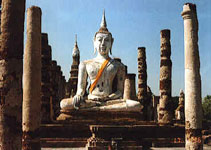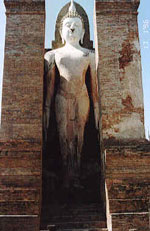Sukhothai (literally Dawn of Happiness), founded in 1238, was the capital of a Thai kingdom considerably larger than Thailand is now, for approximately 120 years. Today, it's just the capital of Sukhothai Province with an area of 6,596sqkm (2,546sqmi), approximately 427km (267mi) north of Bangkok.
It is believed the Thai people originated some 4,500 years ago in the Ulthai mountain area of present-day Mongolia. Subsequent migrations took them to South China where they formed a kingdom called Nanchao and from South China to the Indo-Chinese peninsula.
The southward migration received marked impetus during the time of Kublai Khan who was rapidly expanding his empire towards Southern China during the 13th century, resulting in a quite numerous Thai population in a region where Khmers and Mons were the established settlers.
Thais settled in various parts of the north of what is today Thailand and established city states which were not much connected to each other. In the middle of the 13th century, two Thai princes in the Sukhothai area, Phor Khun Pha Muang of Muang Rad and Phor Khun Bang Klang Thao of Muang Banyang combined their forces and fought off the Khmers who commanded an extensive empire on the Indo-Chinese empire at that time.
They drove the Khmers out of Sukhothai, then a major frontier post of the Angkorian (Khmer) Empire, and established it as their capital in 1238. Phor Khun Bang Klang Thao, urged by the people to be King, was enthroned with the royal title of Phor Khun Si Sri Inthrathit.
Sukhothai became the first kingdom where before smaller Thai principalities had existed, mostly under Khmer overrule. Thais today view Sukhothai as the cradle of the Thai nation.
King Si Sri Inthrathit had two sons, Phor Khun Ban Muang and Phor Khun Ramkhamhaeng. After his death, Phor Khun Ban Muang, succeeded him first. His brother, Phor Khun Ramkhamhaeng, ascended the throne in 1278 and reigned for 40 years.
One of Thailand's greatest warriors, King Ramkhamhaeng made Sukhothai a powerful and extensive kingdom which included many parts of what are today neighboring countries.
King Ramkhamhaeng opened direct political relations with China and made two trips to China - the first in 1282 to visit the Emperor Kublai Khan and the second in 1300 after Kublai Khan's death.
From the second visit he brought back Chinese artisans who taught the Thais the art of pottery. Today the old Sangkhalok potteries are eagerly sought by collectors.
A major achievement of King Ramkhamhaeng was the revision of various forms of Khmer alphabets into a system suitable for the writing of Thai words. The Thai alphabet of today is essentially the same as the one Ramkhamhaeng invented in 1283.
Thais today have a fairly romantic perception of Sukhothai as a kingdom of happiness. Actually, this perception is partially based on historic records. A famous stone inscription reads in part: "This Muang Sukhothai is good. In the water there are fish, in the field there is rice. The ruler does not levy a tax on the people who travel along the road together, leading their oxen on the way to trade and riding their horses on the way to sell. Whoever wants to trade in elephants, so trades. Whoever wants to trade in horses, so trades. Whoever wants to trade in silver and gold, so trades."
King Ramkhamhaeng also promoted religion and, through his efforts, Buddhism became strongly embedded in Thai culture, giving birth to classic forms of Thai religious arts. Images of Buddha sculptured during the Sukhothai era are cultural treasures which impart a feeling of peace and serenity.
A total of eight kings ruled Sukhothai. The gradual decline of Sukhothai occurred during the reigns of the last two kings. The end of this first Thai Kingdom came in 1365 when it was degraded into a vassal state of Ayutthaya, the young and rising power to the south.
The former greatness of Sukhothai has been preserved in architectural monuments. Ruins of the royal palaces, Buddhist temples, the city gates, walls moats, dams, ditches, ponds, canals and the water dyke control system which was the economic base of the kingdom has been restored by the Fine Arts Department with the cooperation of the UNESCO, not only to foster Thailand's national identity but safeguard an important part of mankind's cultural heritage.
The new town of Sukhothai, a few kilometers away from the old one, is where hotels, restaurants and other infastructure facilities are located today.
What To See
The Royal Palace and Wat Mahathat
The royal palace lies in the center of the old town and covers an area of 160,000sqm (16 hectares, roughly 40 acres), about one fourth of the area of the town within the walls. The palace compound is surrounded by a moat and contains two main sections; the royal residence and the palace temple, Wat Mahathat.

Photo: Giant Buddha among the ruins of Wat Mahathat in Sukhothai
The famous stone inscription of King Ramkhamhaeng was found here by King Mongkut in the 19th century, together with a piece of the stone throne called Manangkhasila Asana. King Ramkhamhaeng had this throne in the midst of a sugar palm grove where, at his request, a monk preached on Buddhist Sabbath days and the king conducted the affairs of state on other days. This throne was later installed in Bangkok's Temple of the Emerald Buddha.
The sanctuary lies to the west behind the actual royal palace. It is Sukhothai's largest wat and has a customary main Chedi in lotus-bud shape and a ruined Vihara (hall). At the base of the Chedi stand figures of Buddhist disciples in adoration. On the pedestal are seated Buddha images. In front of this reliquary is a large Vihara which originally contained a remarkable seated bronze Buddha in Sukhothai style, cast and installed by King Lithai of Sukhothai in 1362. At the end of the 18th century, the image was removed to the Vihara Luang of Wat Suthat in Bangkok by order of King Rama I and has since been named Phra Si Sakaya Muni.

Photo: Standing Buddha at Wat Mahathat in Sukhothai
In front of the large Vihara is another smaller Vihara which was probably built during the Ayutthaya period. Its main Buddha image (8m (26ft) high was installed inside a separate building. In front of the southern image a piece of sculpture called Khom Dam Din (a Khmer who came by way of walking underground) was found. It is now kept in the Mae Ya Shrine near the Sukhothai Administrative Building.
To the South stands a pedestal of a large Chedi built up in steps. The lowest platform is adorned with beautiful stucco figures of demons, elephants and lions with angels riding on their backs. Mural paintings adorn the crypt of this Chedi.
Wat Si Sawai

Photo: The three Hindu-style Prangs of Wat Si Sawai in Sukhothai
Wat Si Sawai is southwest of Wat Mahathat. Three Prangs are surrounded by a wall. Inside the wall, the Vihara in the west is separate from the main Prang which was constructed in Lopburi or Hindu style. The other Viharas beside the Prangs are Buddhist. The compound was obviously first a Hindu shrine but later converted into a Buddhist monastery.
Wat Phra Phai Luang

Photo: Prang at Wat Phra Phai Luang in Sukhothai
This temple, approximately 500m (1635ft) north of San Luang Gate, used to be a Khmer Hindu shrine but was later converted into a Buddhist monastery, surrounded by a moat. In Sukhothai, it is second in importance to Wat Mahathat. Inside are three Prangs like the one of Wat Si Sawai but the southern and the central ones have crumbled, leaving only the northern one which is decorated with stucco figures.
In front of these Prangs are a Vihara and a crumbled Chedi; the later has a pedestal decorated with stucco seated Buddha images.



